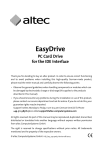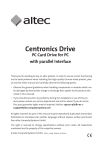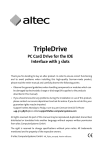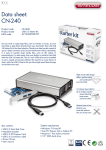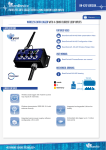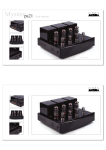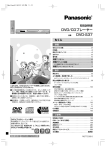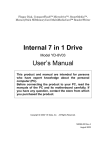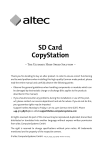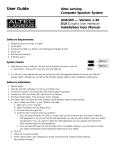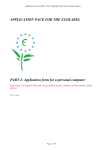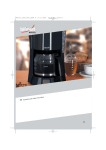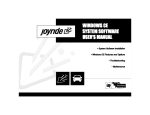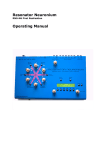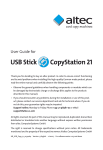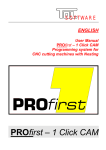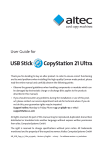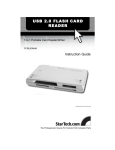Download i-Drive - altec ComputerSysteme
Transcript
i-Drive internal PC Card Drive with SCSI-2 interface Thank you for deciding to buy an altec product. In order to ensure correct functioning and to avoid problems when installing this high-quality German-made product, please read the entire manual and carefully observe the following points: • Observe the general guidelines when handling components or modules which can be damaged by electrostatic charge or discharge (this applies to the products described in this manual). • If you should encounter any problems during the installation or use of this product, please contact our service department and ask for advice. If you do not do this, your guarantee rights may be impaired. Support hotline, Monday to Friday, 11 am to 3 pm German time (CET): Phone +49-511-9 83 81-70 or eMail [email protected] All rights reserved. No part of this manual may be reproduced, duplicated, transcribed, distributed or translated into another language without express written permission from altec ComputerSysteme GmbH. The right is reserved to change specifications without prior notice. All trademarks mentioned are the property of the respective owners. © altec ComputerSysteme GmbH. HB_i_Drive_e21.qxd4 Version 07/2002. altec ComputerSysteme GmbH disclaims all liability for errors in this manual. Liability for direct or consequential damages which arise in connection with the use of this documentation is specifically excluded insofar as this does not contradict the law. Table of contents 1. Introduction 3 1.1 Product description 3 1.2 Features 3 1.3 Scope of delivery 3 2. Hardware installation 4 2.1 Assembly 4 2.2 Power supply 4 2.3 SCSI connection 4 2.4 SCSI termination 5 2.5 Terminator power 6 2.6 Configuring the SCSI address 6 3. Host Software 7 3.1 Operating system-dependent information 7 3.2 IBM compatible PCs under DOS, OS/2,Windows 95/98 7 3.3 Apple Macintosh computers 8 4. Using the i-Drive 9 4.1 Inserting a PC Card 9 4.2 Removing a PC Card 9 5. Technical specifications i-Drive 10 6. Supported storage media 11 User Manual i-Drive 2.1 2 1. Introduction 1.1 Product description The altec i-Drive is a drive for PC Card storage media and supports all standard PC Card ATA or SRAM media and PC Card hard disks. The front of the i-drive has slots for two Type II PC Cards or one Type III PC Card. The standard SCSI interface of the i-Drive makes it easy to connect to desktop PCs, Macintosh computers and workstations. It allows rapid data transfer or data exchange using exchangeable PC Card storage media. The i-Drive is manufactured for commercial and industrial applications. It has all performance features required by PCs, digital cameras, High Performance Embedded Systems and portable computers and is designed for cost-saving and user-friendly support of PC Card storage media. The i-Drive is available as an internal version. It is manufactured as a 3.5" standard chassis for installation in 3.5" or 5.25" drive bays. 1.2 Features ◆ State-of-the-art PC Card technology for computers with a SCSI interface ◆ Operating system independent – supports MS-DOS,Windows 95/98, NT, 2000, ME and XP, OS/2, UNIX and Apple Macintosh OS 7.1 to 9.x (OS X not tested) ◆ 2 slots for PC Card Type I and II storage media or 1 slot for PC Card Type III ◆ High-speed data transfer – up to 10 MB/s (synchronous) or 5 MB/s (asynchronous) ◆ Simple, quick, compatible: easy installation, SCSI-2 interface, PC Card standard ◆ Configurable with jumpers and SCSI ID switch ◆ The two PC Card slots are assigned to 2 separate logical SCSI units (LUNs) ◆ Automatic recognition of the storage medium (PC Card ATA, SRAM and linear flash PC Cards) and memory capacity, even with unformatted PC Cards 1.3 Scope of delivery ◆ PC Card Drive in 3.5" chassis with SCSI-2 interface (50 pin, 8-bit) ◆ Power supply cable adapter 5.25" to 3.5" ◆ Mounting screws ◆ Instruction manual 3 User Manual i-Drive 2.1 2. Hardware installation Please note the following when installing the i-Drive: 2.1 Assembly ➜ Attention: Switch off the power supply to the computer before removing the computer’s case. The i-Drive can be installed in any unused 3.5" or 5.25" drive bay. The threaded holes at the side correspond to those of a 3.5" standard floppy drive and are positioned such that the front panel of the i-Drive is flush with the front of the computer’s case. The threaded holes at the bottom of the i-Drive are used to attach the drive to a standard 5.25” drive mounting kit. The i-Drive can be installed in the computer at any angle. 2.2 Power supply The i-Drive has a standard power connector for 3.5" floppy drives. Attach an unused power connector from the computer’s power supply to the power connector on the i-Drive. If necessary, use the supplied power supply cable adapter 5.25" to 3.5". Rear view of the i-Drive 2.3 SCSI connection The i-Drive is connected SCSI bus with a standard SCSI 50-pin 2-row ribbon cable connector (pins on a 0.1" grid). ➜ Attention: If the connector on the ribbon cable does not have a polarizing key, make sure that the red mark or arrow on the edge of the ribbon cable connects to pin 1 of the SCSI connector ! User Manual i-Drive 2.1 4 2.4 SCSI termination ➜ Attention: The SCSI devices which are located at the two ends of the SCSI bus must be terminated. All other devices must not be terminated. Examples: Controller i-Drive Harddisk terminated not terminated terminated Harddisk Controller i-Drive terminated not terminated terminated To enable SCSI termination for the i-Drive, insert jumper 6 on jumper block S1. In addition, one of the SCSI devices must provide the power supply for the termination, the so-called terminator power. The terminator power is normally supplied by the SCSI controller. If the SCSI controller or the other SCSI devices do not supply terminator power, enable terminator power for the i-Drive by inserting jumper 5 on jumper block S1 (see 2.5). Jumper 6 on jumper block S1 enables or disables SCSI bus termination on the i-Drive as follows: Termination on* Termination off 1 = Jumper inserted Jumper block S1 Jumper 6 1 0 0 = Jumper removed 5 * = Factory setting User Manual i-Drive 2.1 2.5 Terminator power Jumper 5 on jumper block S1 is used to enable or disable the terminator power for the i-Drive. This is normally unnecessary because terminator power is normally supplied by the SCSI controller. Terminator power on Terminator power off* 1 = Jumper inserted Jumper block S1 Jumper 5 1 0 0 = Jumper removed * = Factory setting 2.6 Configuring the SCSI address Each of the maximum of 8 devices connected to the 8-Bit SCSI Bus must have a unique SCSI address, also called SCSI ID. The SCSI address of the i-Drive is configured with Jumpers 1 to 3 on jumper block S1 as shown in the table: SCSI-ID S1 Jumper 1 S1 Jumper 2 S1 Jumper 3 ID 0 ID 1 ID 2 ID 3 ID 4 ID 5* ID 6 ID 7 0 1 0 1 0 1 0 1 0 0 1 1 0 0 1 1 0 0 0 0 1 1 1 1 1 = Jumper inserted 0 = Jumper removed * = Factory setting To avoid conflicts with other SCSI devices, make sure that each device has its own unique SCSI ID. ➜ Note: the SCSI controller itself is also a SCSI device and usually has the SCSI ID 7. The internal hard disk usually has the SCSI ID 0. User Manual i-Drive 2.1 6 Please check the following once again before closing the computer’s case: 1. 2. 3. 4. 5. 6. Correct mounting of the i-Drive Power supply connection for the i-Drive (3.5" drive power supply connector) Correct connection of the i-Drive to the SCSI bus Correct SCSI termination (depending on configuration) Terminator power (depending on configuration) Correct configuration of the SCSI address (depending on configuration) 3. Host software 3.1 Operating system-dependent information The i-Drive is a SCSI drive for exchangeable PC Card storage media. Exchangeable SCSI media are normally supported by the SCSI device driver of your computer’s SCSI controller. However, in some cases you may encounter compatibility problems with exchangeable media depending on the type of controller and the operating system. The following section contains information for commonly-used operating systems. 3.2 IBM compatible PCs under DOS, OS/2, Windows 95/98 a) Operating system support Many SCSI controllers with their own on-board BIOS firmware install exchangeable storage media as non-exchangeable hard disks if storage media is already inserted in the drive when the controller BIOS is initialized. Some BIOS implementations have specific support for exchangeable storage media. We recommend you to: Remove the PC Card from the i-Drive before booting the PC! Note: with some BIOS implementations, this results in a very long boot time. We also recommend you to: Disable the write cache! In order to ensure reliable exchangeability of the storage media, you should use an exchangeable media device driver which is appropriate for your SCSI controller. Generally speaking, exchangeable media device drivers are supplied with the SCSI controller or can be obtained from the manufacturer or supplier. 7 User Manual i-Drive 2.1 b) Data exchange between different computer systems Generally speaking, data exchange with PC Card storage media functions without any problems between different computer systems. Most exchangeable media device drivers treat SCSI exchangeable media as exchangeable hard disks, i.e. the media must be partitioned. This is done with suitable partitioning or formatting programs. One of the exceptions is OS/2 Warp, which treats SCSI exchangeable media as high capacity diskettes without partitioning. Accordingly, you cannot exchange PC Card media between DOS and OS/2 systems. Reliable data exchange between different computer systems is only guaranteed with ATA Flash PC Cards (e.g. SanDisk) and ATA hard disks, since these media satisfy the requirements of modern SCSI exchangeable media device drivers. These types of storage media are always partitioned. 3.3 Apple Macintosh computers When configuring the SCSI ID, do not use ID 0 and 7 because they are usually used by the internal hard disk and/or the SCSI interface adapter, respectively. altec has tested the i-Drive with different models of Macintosh computer under MacOS versions 7.1 and 7.5 The Macintosh operating system automatically looks for devices on the SCSI bus when the system boots, and automatically recognizes the altec i-Drive as a SCSI device. However, for reliable exchange of data, you should use an appropriate Apple-compatible driver. This also allows data to be exchanged with DOS computers. User Manual i-Drive 2.1 8 4. Using the i-Drive 4.1 Inserting a PC Card After installing the altec i-Drive and starting the computer, you should see two removable drives which correspond to the two PC Card slots in the drive. You can use two Type I or Type II PC Cards simultaneously. Alternatively, you can use a single Type III PC Card in the lower slot. A small marker (arrow or triangle) on the label of the PC Card shows which end to insert in the drive (the label with the arrow or triangle is attached to the top side of the card). The i-Drive recognizes the storage media type and the memory capacity automatically. Analogously to diskette drives, you must only insert or remove PC Cards when the red LED on the front panel of the drive is not lit.The LED lights up after inserting a PC Card until initialization is finished and also when data on the PC Card is being accessed. 4.2 Removing a PC Card Press the respective eject button to remove the PC Card from the slot. Press the left eject button for the top slot and/or the right eject button for the bottom slot. Make sure that the red LED on the front panel of the drive is not lit when you remove the PC Card. 9 User Manual i-Drive 2.1 5. Technical Specifications i-Drive Memory card slots 2 x Type I or II, or 1 x Type III PC Card, incl. SRAM Cards Interface SCSI-2 (Fast SCSI); 8-bit single-ended; standard SCSI 50 pin, 2.54 mm pin spacing Supported OS e.g. Windows 95/98, ME, NT, 2000, XP, MS-DOS, OS/2, Unix, Linux, MacOS Dimensions L xWxH: 149 mm x 101.6 mm x 25.4 mm; standard 3.5" drive dimensions Environmental Specs Temperature 0°C to +70°C (operating) –20°C to +70°C (non-operating) Humidity 0 to 90% (non-condensing) DC input voltage 5Volt ±5% Power consumption 150 mA (w/o memory) User Manual i-Drive 2.1 10 6. Supported storage media ◆ SanDisk Type II ATA PC Cards Storage capacities: 16 MByte – 2,0 GByte* ◆ SanDisk CompactFlash memory cards Type I and Type II (use an appropriate PC Card adapter); IBM Microdrives (use a Type II PC Card adapter) Storage capacities : CF Type I 16 – 512 MByte* ◆ SmartMedia memory cards (use an appropriate PC Card adapter) Storage capacities : 8 – 128 MByte* ◆ SanDisk MultiMediaCards (use the altec SD Card & MultiMediaCard Adapter) Storage capacities: 16 – 64 MByte* ◆ SanDisk SD Cards (use the altec SD Card & MultiMediaCard Adapter) Storage capacities : 16 – 256 MByte* ◆ SanDisk Memory Stick (use an appropriate PC Card adapter) Storage capacities : 8 – 128 MByte* ◆ altec Full Metal Cards Solid (ATA PC Card Type II) Storage capacities : 16 MByte – 2,0 GByte* ◆ altec Full Metal Cards IP54 (ATA PC Card Type II) protected against spray water and dust, industrial temperature range: Operation: –40°C to +85°C; 5 V Storage capacities : 16 MByte – 2,0 GByte* ◆ altec Full Metal Cards IP68 (ATA PC Card Type II) can be immersed in water, industrial temperature range: Operation: –40°C to +85°C; 5 V Storage capacities : 16 MByte – 2,0 GByte* ◆ altec Full Metal Cards Hermetic Military (ATA PC Card Type II) suitable for space applications, meets military standard vacuum, vibration and shock tests, corrosion protection and resistant to all types of fungus, protected against spray water and dust, industrial temperature range: Operation : –40°C to +85°C; 5 V Storage capacities : 16 MByte – 2,0 GByte* * As of 07/2002 Ask for our product overview leaflet or visit our web site for information on the full range of memory media, Drives and Solid State Disks which are available from altec: http://www.altec-computersysteme.com 11 User Manual i-Drive 2.1











